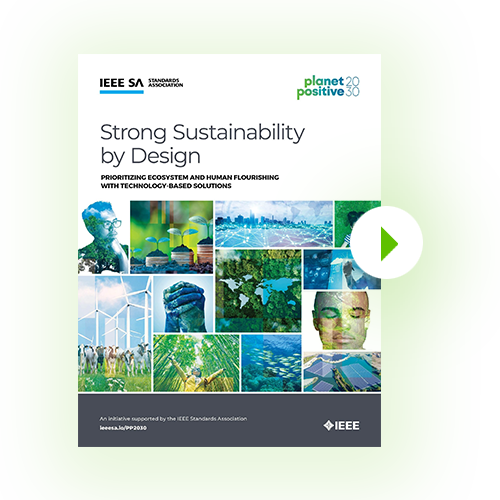Planet Positive 2030 is a IEEE initiative bringing together a global, diverse, and interdisciplinary community of experts outlining a vision towards a sustainable path for all people on Earth for 2030 and beyond. One element of this vision includes description, development, and application of metrics and indicators (e.g. mechanisms to acquire information about our world through data-driven, unbiased approaches to help humanity interpret and understand natural ecosystems). Metrics and indicators measure various elements of our global infrastructure, including human-based (e.g. economics, towns and cities, human wisdom and culture, the arts, etc.) and the natural world (e.g. grasslands, mountains, peatlands, ocean and coasts, rivers and lakes, forests and trees, etc.), such that we can apply this knowledge in the context of our guiding principles towards a more a positive and preserved socioeconomic connection with our planet.
Indeed, addressing all the Planet Positive issues posed through data-driven approaches requires interdisciplinary information (e.g. environmental sciences, socioeconomic models, human health considerations, data acquisition and instrumentation, etc.) to understand holistically the adaptations that are occurring with local to global societies, interactions with the terrestrial and natural environments, and how these circumstances have been and are changing over time. In turn, to understand these multi-factorial and dynamic adaptations requires consideration of our tools available to interpret and make decisions from these data in an objective manner that benefits our local to global societies in a contextualized, integrated, and positive direction. Statistical tools provide a mechanism to organize data and interpret changes at the sample to population level, considering the averages of factors and how, due to different effects, averages change with respect to other factors, while also considering intrinsic and extrinsic variability (e.g. unknowns and unknown and unknowns). Statistics also benefit from larger data sets (e.g. law of large numbers), in particular if sample sets are variable (e.g. compare study designs between basic science and human research; model organisms are designed to have less variability than human studies).
In short, we have highlighted, evaluated, described, and given examples of how metrics and indicators may address various issues that relate with us achieving a more positive planetary experience, including metrics that should honor nature, metrics that are accurate, reliable, and practical, the need for interconnectedness and trade-offs from a global ecological and environmental interdependence standpoint, among others. Here it is elaborated on the issue of sustainably oriented metrics that require being accurate, reliable, and practical, and the role of statistics to addressing and applying beneficial and valuable metrics in both academic and real-world sense.
Moreover, statistical models apply computational tools to compile, calculate, and present metadata, though have various limits that effect their findings in terms of accuracy and precision and may lead to model uncertainties (references: Accounting for uncertainty in ecological analysis: the strengths and limitations of hierarchical statistical modeling; The Strengths and Limitations of the Statistical Modeling of Complex Social Phenomenon: Focusing on SEM, Path Analysis, or Multiple Regression Models; and,Global observed long-term changes in temperature and precipitation extremes: A review of progress and limitations in IPCC assessments and beyond).
Statistical application in the context of Planet Positive first requires organization and developing a framework of the diverse elements and factors associated with our global ecosystem, as exemplified by our various chapters (e.g. economics, forests and trees, rivers and lakes, ocean and coasts, towns and cities, etc.). This design outlines each element and factor of the statistical model, and should be organized into metadata type systems. Moreover, these elements may be independent of each other, though should be integrated together based on observable overlaps, as well as potential indirect interactions (e.g. including and considering for confounding factors). Data is then included within each statistical layer packaged towards presentable outputs that describe factor averages and variation across different contexts, aggregated such that averages that are more like each other are grouped, and variation is interpreted based on contextual nuances that may explain for diverging circumstances and more challenging to predict scenarios.
Statistical model outcomes then provide insight as to how sample populations exist, behave, and adapt, and provide a mechanism to extrapolate towards real-world populations and settings. There exist various statistical and computational models that organize, interpret, and present different scenarios, including climate and weather, economics and socioeconomic distribution and factors, FRB/US project, Innovation Atlas, human health (e.g., Earth observation models / geography), and species distribution and ecological niche models:
- What can community ecologists learn from species distribution models? (Ecosphere)
-
eSDM: An Ensemble Tool for Species Distribution Models (NOAA Fisheries)
- Biodiversity Informatics
- EcoCommons
- Environmental Niche Modelling
Combining and collaborating across these models and topics is one approach to learn how to address the issues identified in Metrics/Indicators, as well as other chapters, from our Planet Positive 2030 project, such as from our recommendations and guiding principles.
However, the advancement and development of AI/ML toolsets may provide strategies and processes to guide inputs of larger and more complex data sets (e.g. multi-factorial and inter-disciplinary correlations) into statistical models so that these model outputs are more realistic, precise, and accurate, and in-turn, allow us to make more informed decisions, and in an ideal circumstance, at the individual level (based from contextualized population data outcomes). Moreover, AI/ML may also have the potential to optimize data pipelines and make them more efficient, such that less computing processing power is required. Indeed, AI/ML tools may provide a mechanism to address current statistical model limitations, as well as combine multiple datasets from different models to develop more accurate, real-time, and predictive models that are interdisciplinary, more comprehensive, and holistic, enabling us to understand our world, its ecosystems, and our socioeconomic framework in more sophisticated, factual, and contextualized manner such that we may also make progress together towards a positive planet by 2030.
Dr. Anand “Sunny” Narayanan is currently a Research Faculty at Florida State University, with research focuses in the areas of space and medical physiology. Dr. Narayanan has an interdisciplinary background in engineering and biomedical sciences, with projects studying the effects of spaceflight on physiological structure and function, researching and identifying treatments for medical diseases and conditions (e.g. auto-immune conditions), and global health initiatives addressing acute and chronic conditions aimed at enhancing patient care of individuals in disadvantaged communities. His involvement with IEEE Planet Positive 2030 has enabled him to apply his academic experiences in understanding and addressing how human health is and will be impacted by climate change, and how these adaptations may be improved through technology-based solutions.



